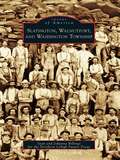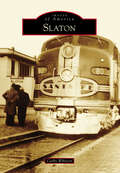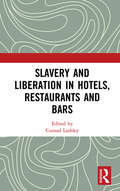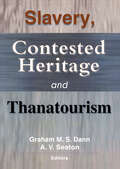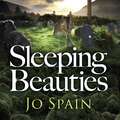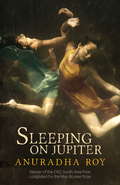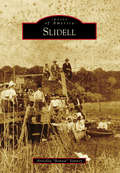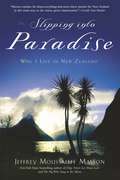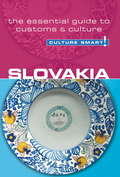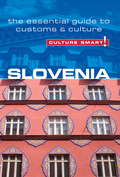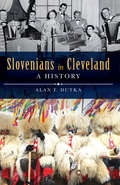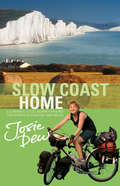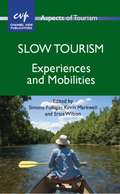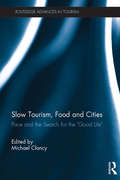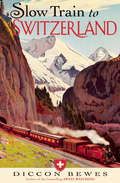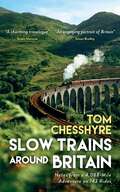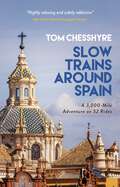- Table View
- List View
Slatington, Walnutport, and Washington Township
by Sean Billings Northern Lehigh Future Focus Johanna BillingsThe photographs in Slatington, Walnutport, and Washington Township show readers what the area looked like from when it was a slate quarrying community through the canal era to the present. Among the views are images of a Lehigh Valley Railroad train accident that led to the demolition of the Slatington station, soapbox derby races down Main Street in Slatington, the Lehigh Canal in Walnutport, and life in the slate quarry towns of Slatedale, Emerald, and Washington Township.
Slaton
by Cathy WhittenSlaton, Texas, has a very rich and interesting history. The journey began in 1911 with the clickety-clack of the railroad track of the Santa Fe Railroad. Slaton was named after local rancher and banker O.L. Slaton on May 11, 1911. It was nicknamed "Tent City" in the beginning, because the first citizens lived in tents while construction began on small framed houses and buildings. June 15, 1911, was the official opening day of the city as people came by train, wagon, and on foot. Soon, the Harvey House restaurant was established, giving not only delicious cuisine but also meals served by attentive and attractive women who became known as the Harvey girls. Slaton became the center of the largest division in the Santa Fe system, servicing four daily northbound and southbound trains between Amarillo and Sweetwater. Today, you still hear the lonesome sound of the Santa Fe rolling through town, and the Harvey House is still open to the public. Slaton is a small West Texas community of approximately 6,129 citizens and is located 15 miles southeast of Lubbock.
Slavery and Liberation in Hotels, Restaurants and Bars
by Conrad LashleyThis is the first book to explore workforce slavery and liberation together within commercial hotel, restaurant and bar activities, the hospitality industry being particularly vulnerable to potential illegal action and reputational damage via involuntary involvement in human trafficking and sexual exploitation. Slavery is the most oppressive form of labour exploitation and is illegal in Western Europe and most of the industrialised world. On the other hand, ‘neo-slavery’ oppresses the powerless through low pay and employment practices that predominantly serve the interests of the employer. This book explores the most exploitative forms of slavery, 'neo-slavery' and human trafficking in the hotel industry, and offers insights into empowerment through liberative trade unions and worker co-operatives. The study’s multifaceted cross-cultural approach includes in-depth chapters on Brazil and the Netherlands as well as a multitude of examples from the UK, exposing the topic as an international problem. Written by international specialists, this significant book will appeal widely to upper-level students and researchers in hospitality, and specifically, to all those interested in human resource management in the hospitality and hotel industry, as well as human rights issues and business ethics.
Slavery, Contested Heritage, and Thanatourism (Journal Of Hospitality And Tourism Administration Ser. #Vol. 2, Nos. 3-4)
by Graham M.S. Dann A.V. SeatonFirst published in 2002. Routledge is an imprint of Taylor & Francis, an informa company.
Sleeping Bags to S'mores: Camping Basics
by Heather Balogh Rochfort William RochfortFrom choosing a destination and staying safe to what to cook and doing it on a budget, this guide provides fun advice for tent camping, car camping, and backpacking. Ever wanted to go camping, but had no idea where to start? Need to unplug, but not sure what to do? Do you have childhood memories of camping bliss, but no idea how to do it on your own? Sleeping Bags to S'mores has you covered! From two expert writers on camping and backpacking, this book covers everything you need to know about how to go camping. From picking a destination and what to pack to how to deal with wildlife (including kids), sporty guides Heather and Will Rochfort will show you the way. Sleeping Bags to S'mores is everything you need to know to have the relaxing, fun-filled camping experience you're looking for, and it includes 100 entertaining full-color illustrations.
Sleeping Beauties: An incredibly engrossing serial-killer thriller packed with tension and mystery (An Inspector Tom Reynolds Mystery Book 3) (An Inspector Tom Reynolds Mystery #3)
by Jo SpainTHE THIRD TOM REYNOLDS MYSTERY FROM THE INTERNATIONALLY BESTSELLING AUTHOR OF THE PERFECT LIE'Fiendishly clever...' - Irish Sunday IndependentThe inspector frowned and examined the earth under the trees. As he scanned the glade, his stomach lurched. One, two, three, four. Five, counting the mound of earth disturbed under the tent. Somebody had cleared the earth of its natural layer and sown their own flowersIn five placesFive gravesA young woman, Fiona Holland, has gone missing from a small Irish village. A search is mounted, but there are whispers. Fiona had a wild reputation. Was she abducted, or has she run away?A week later, a gruesome discovery is made in the woods at Ireland's most scenic beauty spot - the valley of Glendalough. The bodies are all young women who disappeared in recent years. D.I. Tom Reynolds and his team are faced with the toughest case of their careers - a serial killer, who hunts vulnerable women, and holds his victims captive before he ends their lives.Soon the race is on to find Fiona Holland before it's too late. . .Discover more DI Tom Reynolds with the next instalment of the acclaimed series, The Darkest Place.For even more Jo Spain, be sure to check out her most exciting and thrilling work yet, The Perfect Lie.(P)2017 WF Howes Ltd
Sleeping Beauties: a chilling and unmissable thriller (An Inspector Tom Reynolds Mystery Book 3)
by Jo Spain'Five stars' Amazon reviewer'What a read!'Amazon reviewer'I was engrossed right from the start and read it in one long, very satisfied sitting'Amazon reviewerTHE BESTSELLING AUTHOR OF WITH OUR BLESSING AND BENEATH THE SURFACE RETURNS WITH A BRAND NEW SERIAL-KILLER THRILLER. The inspector frowned and examined the earth under the trees. As he scanned the glade, his stomach lurched. One, two, three, four. Five, counting the mound of earth disturbed under the tent. Somebody had cleared the earth of its natural layer and sown their own flowersIn five placesFive gravesA young woman, Fiona Holland, has gone missing from a small Irish village. A search is mounted, but there are whispers. Fiona had a wild reputation. Was she abducted, or has she run away? A week later, a gruesome discovery is made in the woods at Ireland's most scenic beauty spot - the valley of Glendalough. The bodies are all young women who disappeared in recent years. D.I. Tom Reynolds and his team are faced with the toughest case of their careers - a serial killer, who hunts vulnerable women, and holds his victims captive before he ends their lives. Soon the race is on to find Fiona Holland before it's too late. . .'Deft plotting and expert handling of tension make for an intelligent mystery' Guardian
Sleeping Beauties: a chilling and unmissable thriller (An Inspector Tom Reynolds Mystery Book 3) (An Inspector Tom Reynolds Mystery #3)
by Jo Spain'Five stars' Amazon reviewer'What a read!' Amazon reviewer'I was engrossed right from the start and read it in one long, very satisfied sitting' Amazon reviewerTHE BESTSELLING AUTHOR OF WITH OUR BLESSING AND BENEATH THE SURFACE RETURNS WITH A BRAND NEW SERIAL-KILLER THRILLER. The inspector frowned and examined the earth under the trees. As he scanned the glade, his stomach lurched. One, two, three, four. Five, counting the mound of earth disturbed under the tent. Somebody had cleared the earth of its natural layer and sown their own flowersIn five placesFive gravesA young woman, Fiona Holland, has gone missing from a small Irish village. A search is mounted, but there are whispers. Fiona had a wild reputation. Was she abducted, or has she run away? A week later, a gruesome discovery is made in the woods at Ireland's most scenic beauty spot - the valley of Glendalough. The bodies are all young women who disappeared in recent years. D.I. Tom Reynolds and his team are faced with the toughest case of their careers - a serial killer, who hunts vulnerable women, and holds his victims captive before he ends their lives. Soon the race is on to find Fiona Holland before it's too late. . .'Deft plotting and expert handling of tension make for an intelligent mystery' Guardian
Sleeping on Jupiter
by Anuradha RoyLONGLISTED FOR THE MAN BOOKER PRIZE 2015A stark and unflinching novel by a spellbinding storyteller, about religion, love and violence in the modern world.A train stops at a railway station. A young woman jumps off. She has wild hair, sloppy clothes, a distracted air. She looks Indian, yet she is somehow not. The sudden violence of what happens next leaves the other passengers gasping.The train terminates at Jarmuli, a temple town by the sea. Here, among pilgrims, priests and ashrams, three old women disembark only to encounter the girl once again. What is someone like her doing in this remote corner, which attracts only worshippers?Over the next five days, the old women live out their long-planned dream of a holiday together; their temple guide finds ecstasy in forbidden love; and the girl is joined by a photographer battling his own demons.The full force of the evil and violence beneath the serene surface of the town becomes evident when their lives overlap and collide. Unexpected connections are revealed between devotion and violence, friendship and fear, as Jarmuli is revealed as a place with a long, dark past that transforms all who encounter it.
Sleeping on Jupiter: A Novel
by Anuradha RoyLONGLISTED FOR THE MAN BOOKER PRIZE 2015A stark and unflinching novel by a spellbinding storyteller, about religion, love and violence in the modern world.A train stops at a railway station. A young woman jumps off. She has wild hair, sloppy clothes, a distracted air. She looks Indian, yet she is somehow not. The sudden violence of what happens next leaves the other passengers gasping.The train terminates at Jarmuli, a temple town by the sea. Here, among pilgrims, priests and ashrams, three old women disembark only to encounter the girl once again. What is someone like her doing in this remote corner, which attracts only worshippers?Over the next five days, the old women live out their long-planned dream of a holiday together; their temple guide finds ecstasy in forbidden love; and the girl is joined by a photographer battling his own demons.The full force of the evil and violence beneath the serene surface of the town becomes evident when their lives overlap and collide. Unexpected connections are revealed between devotion and violence, friendship and fear, as Jarmuli is revealed as a place with a long, dark past that transforms all who encounter it.
Slidell
by Arriollia Bonnie" VanneySlidell's first settlement was established on Bayou Bonfouca in 1852, and by 1883, when the railroad was completed and the town was named, it already was dubbed "the industrial capital of the South." Slidell's port was busy with 314 sailing vessels per year traveling to the Port of New Orleans carrying lumber, bricks, and food. The train brought workers, settlers, and, in later years, tourists to the area. Nestled in the "Ozone Belt," the fresh air and water had a healing power that attracted people from all over to bathe in and drink it. Shipbuilding began as early as the first settlers and continued until 1993. With the arrival of the space program, Slidell grew rapidly from a small town to a city of over 6,000. Located three miles from Lake Pontchartrain and minutes away from New Orleans, it is a quiet community on the north shore today.
Slipping into Paradise: Why I Live in New Zealand
by Jeffrey Moussaieff MassonIn the tradition of Under the Tuscan Sun and A Year in Provence, here is Jeffrey Moussaieff Masson's ode to his personal paradise-his adopted home, New Zealand. After living in California, why did Masson settle- out of all the places on earth-in such a faraway land? It turns out that while visiting a beautiful sandy beach just fifteen minutes from bustling Auckland, Masson and his family were utterly seduced by the exotic locale. There was little deliberation. This place, surrounded by lush forest on a bay dotted with volcanic islands, would be their new home.Masson takes readers on a remarkable journey to another world, as he and his family "slip into" the paradise that is New Zealand. For anyone who has ever dreamed of finding utopia, Masson reveals a country where neighbors talk to one another and provide a sense of real community-rarely, outside of the big cities, locking their doors-and where politics are as mellow as the weather. New Zealand is also a land of spectacular scenery, made even more famous for being the shooting location for the Lord of the Rings films. The flora is plentiful. Mangroves, banana plants, papaya trees, and more than ten thousand species of ferns grow wild and freely. The fauna is benign. There are no snakes, tarantulas, or scorpions. Children can walk to school barefoot without a care- there is nothing to sting them, bite them, or give them a rash. In the blue waters near the lush coastline, dolphins and orcas abound. While describing his love affair with the country and his affinity for its citizens, Masson reflects on the meaning of home, the importance of acting on intuition, and what happens when we lose our connection to the place we live in. Responding to an impulse, Masson reveals, he realized a dream.Featuring a its glossary of phrases used by New Zealanders and important Maori words, as well as the author's recommended travel itinerary, Slipping into Paradise is ideal for anyone planning a visit to this exquisite land. Full of photographs, delightful anecdotes, and little-known facts (jogging, for example, was invented in New Zealand), Slipping into Paradise is also a book for those who fantasize about dramatically changing their lives-and who imagine something better for themselves. Jeffrey Masson's message: New Zealand awaits.From the Hardcover edition.
Slovakia - Culture Smart!
by Brendan EdwardsSlovakia has struggled with a low international profile. Often overlooked as the Czech Republic's little sister, it is a young country with an old culture and history, and a people who are proudly Central (not Eastern) European. Although for much of the twentieth century Czechs and Slovaks lived together in one state, there are important differences between them, differences that ultimately contributed to separation in 1993 and the rebirth of a sovereign Slovak state.Generally speaking, the Slovaks are more "Slavic" than the Czechs--their pace of life is slower, and their spare time is more often filled with friends, family, and music. They are known to be resistant to change, yet change has been a constant in the state's short economic and political history--from the fall of communism in the Velvet Revolution of late 1989, to the Velvet Divorce of Czechoslovakia in 1993, to widespread economic diversification, expansion, and global influence, to European Union membership in 2004, and the adoption of the euro in 2009-- and they have adapted with quiet optimism.Slovakia has been referred to as the economic "tiger" of Europe, and now that it has EU membership and a healthy industrial economy, Europeans are starting to take notice. Its popularity as a tourist destination has been growing rapidly in recent years. Slovaks call their country the Heart of Europe--a term that describes not only their geography but the Slovak character, which is warm, deeply hospitable, and immensely proud. Visitors who step outside Bratislava's Staré mesto (Old Town) and take the time to explore the country beyond will discover a landscape of plains, meadows, mountains, natural spas, and hundreds of ancient castles, and a people at once modest, stoical, humorous, and responsive.This book captures the essence of what makes the Slovak people unique and explains something of the quirks and memorable aspects of their lifestyle. It opens a window onto their inner world, their customs and celebrations, and describes what to expect and how to behave in different situations. While the country is not without its frustrations for foreigners, most visitors succumb to its charms. Few have left without yearning to return to "the little big country."
Slovenia - Culture Smart!
by Jason BlakeSlovenia seems closer to Austria or Italy than to its Balkan neighbors. The richest of the Slavic nation-states, it has an entirely Western tradition, having belonged in the past to the Roman Empire, the Frankish kingdom, the Holy Roman Empire, the Republic of Venice, the Habsburg monarchy, and the First French Empire. After the Second World War it became part of the Republic of Yugoslavia, before declaring independence in 1991. This extraordinary cultural legacy is what sets Slovenia apart, matched by an amazingly varied topography packed into a small area. Traveling toward the coast, you see changes in the landscape and in the architecture. This reflects both the natural and the historical variety: the Venetians built their buildings one way, the Austrians another.Slovenia's natural beauty is astonishing. Legend relates that when God was allotting nature's bounty, he forgot Slovenia. His last-minute solution was to take bits of the best from other places: gorgeous Alpine ranges, the less craggy Pohorje mountains, the Pannonian plain stretching toward Hungary, hill after hill rolling southward into the horizon, the unique karst landscape, rivers aplenty, and a few miles of Adriatic coastline. Never having had a glorious unified kingdom in the past, Slovenians identify themselves not by blood or history but by their language, which differs from the other languages of the ex-Yugoslavia. The older generation is fluent in Serbo-Croatian, which helps for politics and trade, but has little of its historical baggage, and the country has geo-political importance as a politically stable stepping stone to the Balkans. As far as nationhood goes, Slovenia's golden age is now. There is a sense of change in the country--mostly for the better, and not the dull stampede toward materialism that one sees in some other former Eastern bloc countries. As a tourist destination Slovenia has it all, from medieval ruined monasteries to whitewater rafting. The people of this lovely land are genuinely glad that others are "discovering" their country. There are no real language problems; the younger people all speak English. Moreover, membership of the EU means that this is a country in transition. Culture Smart! Slovenia will introduce you to the inner world of this moderate, orderly, and conservative people who have emerged into the post-Communist world hungry for change.
Slovenians in Cleveland: A History (American Heritage)
by Alan F. DutkaThe Newburgh, St. Clair and Collinwood neighborhoods formed the core of Greater Cleveland's enormous Slovenian population, still the largest in America. The city's Slovenian heritage is replete with gripping tales of World War II prison camp escapes and bizarre bank robbers who threatened the St. Clair Savings institution. The catastrophic East Ohio Gas explosion and tragic Collinwood school fire are etched into local consciousness. The rise of neighborhood residents to professional sports stardom and national political prominence contribute to a proud legacy. And the century-old "Cleveland style" Slovenian polka remains an important cultural expression. Author Alan Dutka offers the first comprehensive history of the struggles and triumphs of Cleveland's Slovenians.
Slow Coast Home: 5,000 miles around the shores of England and Wales
by Josie DewJosie Dew's love of cycling has taken her across the world, travelling everywhere from Japan and Mexico to Iceland, India and Algeria. In her latest book, she sets off on another quirky and riotous ride, choosing to circumnavigate the coastline of the British Isles. And she discovers that her homeland can be as surprising and full of incident as anywhere she has ever been. Beginning in Portsmouth, Josie sets off in a clockwise direction after a Shetland grandmother warns her that she'll end up meeting the devil if she travels anti-clockwise. Through rain, hail, floods, bitter temperatures, minor earthquakes and dusty drought, Josie pedals on, eventually returning to Land's End to complete Stage One of her remarkably lengthy odyssey along 5,000 miles of seaside, estuaries, creeks and islands. But is all as it seems? Who is the mysterious builder who appears at all the wrong moments? Who are the two-wheeled taggers-on lurking in her wake? What did she find at Puckpool Point, Bozomzeal and Woon Gumpus? And how did Josie so badly miscalculate her approach to the seafront at Newhaven that she landed in France?
Slow Coast Home: 5,000 miles around the shores of England and Wales
by Josie DewJosie Dew's love of cycling has taken her across the world, travelling everywhere from Japan and Mexico to Iceland, India and Algeria. In her latest book, she sets off on another quirky and riotous ride, choosing to circumnavigate the coastline of the British Isles. And she discovers that her homeland can be as surprising and full of incident as anywhere she has ever been. Beginning in Portsmouth, Josie sets off in a clockwise direction after a Shetland grandmother warns her that she'll end up meeting the devil if she travels anti-clockwise. Through rain, hail, floods, bitter temperatures, minor earthquakes and dusty drought, Josie pedals on, eventually returning to Land's End to complete Stage One of her remarkably lengthy odyssey along 5,000 miles of seaside, estuaries, creeks and islands. But is all as it seems? Who is the mysterious builder who appears at all the wrong moments? Who are the two-wheeled taggers-on lurking in her wake? What did she find at Puckpool Point, Bozomzeal and Woon Gumpus? And how did Josie so badly miscalculate her approach to the seafront at Newhaven that she landed in France?
Slow Road to Brownsville: A Journey Through the Heart of the Old West
by David ReynoldsAn adventurous Englishman explores the forgotten landscape of America&’s Wild West in this &“illuminating, elegantly written travelogue&” (Financial Times). In his acclaimed memoir Swan River, David Reynolds invited readers into the world of his youth, growing up in Manitoba, Canada. Now, in Slow Road to Brownsville, Reynolds brings readers on a road trip along Highway 83, a little-known two-lane highway that runs from his Canadian hometown to the Mexican border at Brownsville, Texas, on the Gulf of Mexico. Enthralled by the myth of the American West and the romance of the open road, Reynolds explores the realities behind both as he makes his way between small towns, gas stations, and motels, hanging out in bars with the locals and learning the stories of this forgotten region that was once the frontier. Along the way he encounters many legendary figures from North American history, including Lewis and Clark, Sitting Bull, Buffalo Bill, Davy Crockett, and even Truman Capote.
Slow Tourism
by Simone Fullagar Kevin W. MarkwellThis book examines the emerging phenomenon of slow tourism, addressing growing consumer concerns with quality leisure time, environmental and cultural sustainability, as well as the embodied experience of place. Drawing on a range of international case studies, the book explores how slow tourism encapsulates a range of lifestyle practices, mobilities and ethics.
Slow Tourism, Food and Cities: Pace and the Search for the "Good Life" (Routledge Advances in Tourism)
by Michael ClancySlow Food began in the late 1980s as a response to the spread of fast food establishments and as a larger statement against globalization and the perceived deterioration of modern life. Since then, slow practices have permeated into other areas, including cities and territories and travel and tourism. This book provides an in-depth examination of slow food, tourism and cities, demonstrating how these elements are intertwined with one other as part of the modern search for "the good life." Part 1 locates the slow concept within the larger social setting of modernity and investigates claims made by the slow movement, examining aesthetic and instrumental values inherent to it. Part 2 explores the practices and places of slow, containing both conceptual and empirical chapters in Italy, the birthplace of the movement. Part 3 provides a comparative perspective by examining the practices in Spain, the UK, Germany and Canada. Slow Tourism, Food and Cities offers key theoretical insights and alternative perspectives on the varying practices and meanings of slow from a cultural, sociological and ethical perspective. It is a valuable text for students and scholars of sociology, geography, urban studies, social movements, travel and tourism, and food studies.
Slow Train to Switzerland
by Diccon Bewes"Fascinating. Charming. Bewes's breezy prose makes him a pleasant travelling companion."-The Spectator (UK)"Very enjoyable. Bewes is a charming guide."-Geographical Magazine"Fans of Bill Bryson will find him a kindred spirit."-The Lady"A brilliant book."-Bookbag"I'm certain that even those of us who think we know a lot about Switzerland will learn something new, and gain that knowledge in a very readable and entertaining way. If you enjoyed Swiss Watching ... then you'll need to get a copy of this book by the same author. Highly recommended."-Swiss Express, the Swiss Railway Society magazineA bestseller in Europe and the United Kingdom, Slow Train to Switzerland is now in paperback! Diccon Bewes, author of the immensely popular Swiss Watching, follows Thomas Cook's groundbreaking tour from England to the Swiss Alps. Bewes uses traveler Jemima Morell's diary from 1863 to retrace the trip and explore the revolutionary affect the journey had on both Britain and Switzerland.Diccon Bewes is a travel writer. A world trip set him up for a career in travel writing, via the scenic route of bookselling. After ten years at Lonely Planet and Holiday Which? magazine, he decamped to Switzerland. In addition to grappling with German, re-learning to cross the road properly, and overcoming his desires to form an orderly line, he has spent the last five years exploring this quirky country. Following the incredible success of Swiss Watching, he is now a full-time writer. See his website at dicconbewes.com.
Slow Train to Switzerland: One Tour, Two Trips, 150 Years and a World of Change Apart
by Diccon BewesIn June 1863 an English lady set off by train on the trip of a lifetime: Thomas Cook's first Conducted Tour of Switzerland. A century and a half later, travel writer Diccon Bewes, author of the bestselling Swiss Watching, decided to go where she went and see what she saw. Guided by her diary, he followed the same route to discover how much had changed and how much hadn't. She went in search of adventure, he went in search of her, and found far more than he expected. Slow Train to Switzerland is the captivating account of two trips through the Alps: hers glimpsing the future of travel, his revisiting its past. Together they make a journey to remember.This is a tale of trains and tourists, of the British and the Swiss, of a Victorian traveller and a modern-day Englishman abroad. It is the story of a tour that changed both Switzerland and the world of travel forever.
Slow Train to Switzerland: One Tour, Two Trips, 150 Years and a World of Change Apart
by Diccon BewesIn June 1863 an English lady set off by train on the trip of a lifetime: Thomas Cook's first Conducted Tour of Switzerland. A century and a half later, travel writer Diccon Bewes, author of the bestselling Swiss Watching, decided to go where she went and see what she saw. Guided by her diary, he followed the same route to discover how much had changed and how much hadn't. She went in search of adventure, he went in search of her, and found far more than he expected. Slow Train to Switzerland is the captivating account of two trips through the Alps: hers glimpsing the future of travel, his revisiting its past. Together they make a journey to remember. This is a tale of trains and tourists, of the British and the Swiss, of a Victorian traveller and a modern-day Englishman abroad. It is the story of a tour that changed both Switzerland and the world of travel forever.
Slow Trains Around Britain: Notes from a 4,088-Mile Adventure on 143 Rides
by Tom ChesshyreJoin travel writer Tom Chesshyre as he celebrates 200 years of passenger railways in a zigzagging tour around the UK. On a series of rides, Tom enjoys the scenery, seeks out the history and heritage, dodges delays (best he can), and lets the rhythm of the clattering rails help him understand what it is about trains that we love so much.
Slow Trains Around Spain: A 3,000-Mile Adventure on 52 Rides
by Tom ChesshyreBetween soaring mountains, across arid deserts, parched plains and valleys of fruit orchards and olive groves, down glittering coastlines and along viaducts towering above plunging ravines… there is no better way to see Spain than by train.Rail enthusiast Tom Chesshyre, author of Slow Trains to Venice, Ticket to Ride and Tales from the Fast Trains, hits the tracks once again to take in the country through carriage windows on a series of clattering rides beyond the popular image of “holiday Spain” (although he stops by in Benidorm and Torremolinos too).From hidden spots in Catalonia, through the plains of Aragon and across the north coast to Santiago de Compostela, Chesshyre continues his journey via Madrid, the wilds of Extremadura, dusty mining towns, the cathedrals and palaces of Valencia and Granada, and finally to Seville, Andalusia’s beguiling (and hot) capital.Encounters? Plenty. Mishaps? A lot. Happy Spanish days? All the way.
